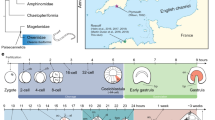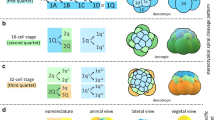Abstract
Recent phylogenetic analyses of ribosomal and protein coding nuclear genes place the marine worms within the Nemertodermatida as one of the oldest lineages among the bilaterian animals. We studied the early embryonic cleavage in Nemertoderma westbladi to provide the first account of nemertodermatid early development. Live embryos were studied with interference microscopy and fixed embryos were either sectioned or studied with confocal laser scanning microscopy. Initially the divisions in the embryo are radial, but then micromeres are shifted clockwise generating a spiral pattern. The four-cell stage is characterized by duets of macromeres and micromeres and thus resembles the duet cleavage reported from members of the Acoela. However, subsequent stages differ from the acoel duet pattern and also from quartet spiral cleavage. The optimization of the cleavage pattern on current phylogenetic hypotheses with Nemertodermatida and Acoela as early bilaterian branches is discussed.


Similar content being viewed by others
References
Apelt G (1969) Fortpflanzungsbiologie, Entwicklungszyklen und vergleichende Frühentwicklung acoeler Turbellarien. Mar Biol 4:267–325
Boyer BC, Henry JJ, Martindale MQ (1998) The cell lineage of a polyclad turbellarian embryo reveals close similarity to coelomate spiralians. Dev Biol 204:111–123
Bresslau E (1909) Die Entwicklung der Acoelen. Verh Dtsch Zool Ges 19:314–323
Ehlers U (1984) Phylogenetisches System der Platyhelminthes. Verh Naturwiss Ver Hamburg (NF) 27:291–294
Ehlers U (1985) Das Phylogenetische System der Plathelminthes. Fischer, Stuttgart
Henry JQ, Martindale MQ, Boyer BC (2000) The unique developmental program of the acoel flatworm, Neochildia fusca. Dev Biol 220:285–295
Hooge MD, Haye PA, Tyler S, Litvaitis MK, Kornfield I (2002) Molecular systematics of the Acoela (Acoelomorpha, Platyhelminthes) and its concordance with morphology. Mol Phylog Evol 24:333–342
Jondelius U, Ruiz-Trillo I, Baguna J, Ruitort M (2002) The Nemertodermatida are basal bilaterians and not members of the Platyhelminthes. Zool Scr 31:201–215
Karling TG (1940) Zur Morphologie und Systematik der Alloeocoela Cumulata and Rhabditophora Lecithophora (Turbellaria). Acta Zool Fenn 26:1–160
Karling TG (1974) On the anatomy and affinities of the turbellarian orders. In: Riser NW, Morse MP (eds) Biology of the Turbellaria. McGraw-Hill, New York, pp 1–16
Lundin K, Sterrer W (2001) The Nemertodermatida. In: Littlewood DTJ, Bray RA (eds) Interrelationships of the Platyhelminthes. Taylor and Francis, London, pp 24–27
Raikova OI, Reuter M, Jondelius U, Gustafsson MKS (2000) The brain of the Nemertodermatida (Platyhelminthes) as revealed by anti-5HT and anti-FMRFamide immunostainings. Tissue Cell 32:358–365
Raikova OI, Reuter M, Gustafsson MKS, Maule A, Halton DW, Jondelius U (2004) Basiepidermal nervous system in Nemertoderma westbladi (Nemertodermatida): GYIRFamide immunoreactivity. Zoology 107:75–86
Reuter M, Raikova OI, Jondelius U, Gustafsson MKS, Maule AG, Halton DW (2001) Organisation of the nervous system in the Acoela: an immunocytochemical study. Tissue and Cell 33:119–128
Ruiz-Trillo I, Paps J, Loukota M, Jondelius U, Baguna J, Ruitort M (2002) A phylogenetic analysis of myosin heavy chain type II sequences corroborates that Acoela and Nemertodermatida are basal bilaterians. Proc Natl Acad Sci U S A 99:11246–11261
Steinböck O (1930/31) Ergebnisse einer von E. Reisinger & O. Steinböck mit Hilfe der Rask-Örsted Fonds durchgeführten Reise in Grönland 1926. 2. Nemertoderma bathycola nov. gen. nov. spec., eine eigenartige Turbellarie aus der Tiefe der Diskobay; nebst einem Beitrag zur Kenntnis des Nemertinenepithels. Vidensk Medd Dan Naturhist Foren Khobenhavn 90:47–84
Steinböck O (1938) Uber die Stellung der Gattung Nemertoderma Steinböck im System der Turbellarien. Acta Soc Fauna Flora Fenn 62:1–28
Sterrer W (1998) New and known Nemertodermatida (Platyhelminthes-Acoelomorpha), a revision. Belg J Zool 128:55–92
Surface FM (1907) The early development of a polyclad, Planocera inquilina Wh. Proc Acad Nat Sci Philadelphia 59:514–559
Tyler S, Rieger RM (1977) Ultrastructural evidence for the systematic position of the Nemertodermatida (Turbellaria). Acta Zool Fenn 154:193–207
Acknowledgements
We would like to thank the staff at Klubban and Tjärnö Marine Biological Stations, especially Per Jonsson for letting us use the inverted microscope. The help from Stefan Gunnarsson and Annette Axén at the microscopy unit at the EBC is gratefully acknowledged. Financial support was received from the Swedish Research Council (grant to U.J.) and from the Wenner-Gren Foundations (U.J./O.R.).
Author information
Authors and Affiliations
Corresponding author
Rights and permissions
About this article
Cite this article
Jondelius, U., Larsson, K. & Raikova, O. Cleavage in Nemertoderma westbladi (Nemertodermatida) and its phylogenetic significance. Zoomorphology 123, 221–225 (2004). https://doi.org/10.1007/s00435-004-0105-8
Received:
Accepted:
Published:
Issue Date:
DOI: https://doi.org/10.1007/s00435-004-0105-8




